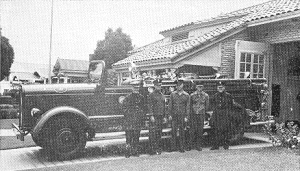|
41s Gets New Apparatus By Harold Scott WHEN
the Sage of San Fernando
Valley, the Emissary from Encino, in a recent article in the Grape Vine,
did dash off a lengthy paper on the new addition to Engine 78, i.e., a new
Kenworth apparatus, the aforementioned correspondent must have had an
inkling that more of them were on the way, for he so states in his
article. May we take this opportunity to tell the world that Gardner Junction, Engine 41 to you, has also placed in service, as of July 26, 1945, another of the Series 900 (Shop No. 914) Kenworths, a little gem sent to replace old Shop No. 120, one of the original LaFrances on the job, and which long ago was outmoded for hill climbing. With most other stations in the adjoining area replacing old, wornout apparatus, it was a pretty sight to see old No. 120 steaming up the side of one of our nearby mountains, and in her own "first-in" district, leading the parade with an accompanying anvil chorus of noise, din and pandemonium, with smoke and steam pouring from every nook and cranny. We have learned from Engine 62 that old Shop No. 120 is ideal for pier fires and sea level operations. Needless to say, the replacing of the old with the new has met the instant approval of fireman and citizen alike, and has placed Gardner Junction once again o a level with other communities, like Sherman Oaks. etc. Shop No. 914 is a duplicate of No. 911 at Engine 78, No. 912 at Engine 77, No. 913 at Engine 44, and has underneath the hood a Hall-Scott engine, of the large sized or "400" series developing 296 H.P. at 2000 RPM. This piece of equipment, better known as a Kenworth Triple Combination Fire Truck, has a height of 93 inches, width 96 inches, overall length 288 inches, with a wheelbase of 181 inches, a weight of 20,740 pounds.
Working in hilly country and climbing up and down the sides of rugged
mountainous area requires very good brakes. These are provided by
Westinghouse air brakes, which are also equipped with two tanks to
build up the pressure. The first tank builds up the pressure to 70 pounds
after which the second tank is charged up to approximately 120 pounds. |
||||
|
In tests up Laurel Canyon it was nothing to go to the top in high gear and important side streets such as Lookout Mountain Road, Stanley Hills Drive and Wonderland Avenue are taken with ease. Streets running off Sunset Boulevard such as Kings Road, Queens Road, Sunset Plaza Drive and Doheny Drive are accomplished without the previous huffing and puffing that the Captain had become so used to. The most efficient operating range of this engine is from abut 1200 RPM. It is poor practice to "lug" this engine much below 1200 RPM under load. It is also poor practice to overspeed engine beyond 1800 RPM. At present there is considerable work being done by the members on both shifts to clean up the apparatus and we hope to have the best and brightest piece of equipment in the department as a standard for other companies to strive toward. What with cleaning the motor, chassis and painting the same we had our work cut out for us, which is now near completion. The members of Engine 41 on the "A" Platoon are Captain M. F. "Happy" Smitson, Engineer Sidney Thayer, Auto-Fireman "Charley" Mohnike, and Firemen "Kenny" Linn and "Ed, the Adonis" Webber. The members of the "B" Platoon are Captain Carl Yager, "Engie" George Reed, Auto-Fireman Harold Scott, and Firemen George Horton, Albert Malcolm, and John Mathews.
The old-timers left in the house are John Mathews and Capt. Yager.
Johnny was assigned at Engine 41 on November 1, 1924 and has been here
ever since and is now the oldest piece of equipment in the house,
Ship No. 120 having been transferred to the beach. Capt. Yager first
set foot at Engine 41s on January 1, 1927, and is still with
us. The other old-timer in the house was an "A"
shifter, Albert Rock, who was in the house for nine and
one-half years before taking his pension on August 17, last.
|
This article appeared in the September 1945 issue of THE FIREMAN'S GRAPE VINE.
LAFIRE.COM
Copyright 2000 All Rights Reserved.
